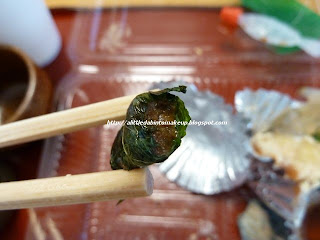Saturday afternoon hubby and I attended a small and intimate book event for a soon to be released cook book titled Kibo at the author's Tokyo home. It was just a nice way of sampling a few of the recipes in the book and to hear the author talks about it in person. Kibo contains traditional recipes from the Tohoku region, or more specifically Iwate, Miyagi, and Fukushima, the 3 prefectures that were most severely affect by the March 11 Tohoku Earthquake and Tsunami as well as the nuclear crisis that followed. It's a tribute of sorts to the food culture of the region as well as to its residents who have seen been displaced.
The book event was "scholarly," but interesting nevertheless, though I have to admit I was more into the food part rather than the actual coming-together of the book ^.^ We all had a tiny portion of samples of Harako Meshi (Salmon Rice with Salmon Roe), fish sausage, shiso leaf stuffed with a mix of miso and grounded walnuts, a sweet salad made of miso, pears, persimmons, and pine nuts, and a pickled side dish made of enoki and chrysanthemum petals.
The Harako Meshi was good, but I think I like the salmon roe that came with it more :P Even the author admitted to us that the cost of the salmon roe by itself was equal to the cost of all the other ingredients combined. So yeah, you bet it was damn fresh and delicious roe!
My second favorite was the fish sausage, which rather chewy and yummy dipped in wasabi soy sauce. The shiso leaf stuff with miso was very interesting too! The miso used in it is Sendai miso, which has a richer but less salty, almost sweet-salty taste. The specific brand used for the shiso wrap shared the same name as the book, Kibo, and while it was sweet, it was actually lighter than a different Sendai miso the author had us passed around for a taste, for comparison's sake.
The shiso leaf was stuffed with a mixture of Sendai miso and grounded walnuts! It was salty but sweet and nutty at the same time! Very interesting!
Anyway, if you're interested the book is only available in ebook format, and a portion of it is going to Japan's recovery efforts.
An added bonus to the event was a small tidbit from a sake expert and we were introduced to 3 highly regarded sakes from the region: the first was a Kimoto sake from Daishichi of Fukushima Prefecture, which had a clean and brisk taste, the second was Nanbu Bijin sake from Nanbu Bijin of Iwate Prefecture, which had a very light but fragrant and fruity taste, probably the best sake I've ever tasted, and the last and my personal favorite (I'm not much of a drinker, you see) Suzune, a sparkling sake (no joke!) from Ichinokura of Miyagi Prefecture.
Kimoto sake (left) and Nanbu Bijin sake (right)

The packaging for Kimoto sake (left) and Nanbu Bijin (right).


My favorite Suzune sparkling sake. I swear I could have just downed the whole bottle. It was delicious! Like a really fruity and sweet champagne!


Apparently the carbonation isn't added to the sake but occurs naturally due the high amount of sugar in the sake after it was bottled. So the end result isn't sugary sweet as the sugar has been mostly "processed" by the chemical reaction that occurs within the sealed bottle.

Another well known snack from the Tohoku region is these senbeis packaged in funny printed plastic wraps!

Inside there is only a nut and 1 senbei, but the packaging is super cute! Check out my sumo and ninja dudes!

















No comments:
Post a Comment